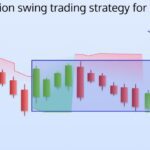Table of Contents
Swing trading is an exciting venture in the world of financial markets, providing traders with the opportunity to capitalize on short to medium-term price movements. To excel in this dynamic environment, mastering candlestick patterns is a crucial skill that can significantly enhance your trading strategy.
Introduction
For ages, candlestick patterns have been an essential element in technical analysis. They offer valuable insights into market sentiment, allowing traders to make informed decisions. Mastering these patterns is particularly beneficial for swing traders, as it helps identify potential trend reversals and continuation points.
Understanding Candlestick Patterns
What Are Candlesticks?
Candlesticks are visual representations of price movements over a specific time period. They consist of a body and wicks, with different patterns conveying distinct market scenarios.

Common Candlestick Patterns
- Bullish Patterns: Bullish patterns signal potential upward movements. Understanding these patterns, such as the Hammer and Morning Star, is essential for recognizing entry points in an upward-trending market.
- Bearish Patterns: Conversely, bearish patterns like the Shooting Star and Engulfing Patterns indicate potential downward movements. Recognizing these signals is crucial for making profitable trades in a declining market.
Significance of Recognizing Patterns
Recognizing candlestick patterns is like deciphering a financial code. It allows traders to anticipate market movements, providing a competitive edge in the fast-paced world of swing trading.
Key Candlestick Patterns for Swing Trading
Doji
The Doji, with its distinctive cross-like appearance, indicates market indecision. Traders often use it to anticipate trend reversals. Doji candlestick can be either red or green in color.

Hammer
The Hammer is a powerful bullish signal, suggesting a potential trend reversal. Its red long lower wick signifies strong buying pressure.

Shooting Star
Conversely, the Shooting Star is a bearish signal, signaling potential downward movement. Traders use it to gauge weakening bullish momentum.

Engulfing Patterns
Engulfing Patterns involve one candle engulfing the previous one, indicating a shift in market sentiment. Recognizing these patterns is crucial for anticipating trend reversals.

Morning and Evening Stars
These patterns are powerful indicators of trend reversals. The Morning Star signals the end of a downtrend, while the Evening Star suggests the conclusion of an uptrend.
Hanging Man and Inverted Hammer
The Hanging Man and Inverted Hammer are similar to the Hammer but have different implications. Traders need to discern these subtle differences for accurate predictions.
Analyzing Market Trends with Candlestick Patterns
Now that we’ve delved into the essential candlestick patterns, let’s explore how to leverage them for a comprehensive analysis of market trends. Recognizing patterns is just the beginning; understanding their implications and integrating them into your trading strategy is the key to successful swing trading.
Identifying Trend Reversal and Continuation Patterns
Candlestick patterns play a crucial role in identifying potential trend reversals and continuations. A sudden change in the pattern, especially after a prolonged trend, can indicate a reversal. On the other hand, continuity in the established pattern suggests the prevailing trend is likely to persist.
Integrating candlestick analysis with trendlines and moving averages enhances the accuracy of trend identification. This synergy enables traders to make informed decisions on whether to enter, exit, or stay in a trade.
Using Candlestick Patterns to Confirm Trend Directions
Candlestick patterns provide valuable confirmation signals for existing trends. For instance, a series of bullish patterns in an uptrend reinforces the likelihood of upward movement. Traders often use this confirmation to reinforce their confidence in holding or adding to their positions.
Conversely, bearish patterns in a downtrend signal the potential continuation of the downward movement. Traders can use this information to make timely exits or consider short positions.
Case Studies Illustrating Successful Swing Trades with Candlestick Analysis
Let’s examine a real-world example to illustrate the practical application of candlestick analysis in swing trading.
- Case Study: Bullish Engulfing Pattern
Imagine you’re monitoring a stock that has been in a downtrend for some time. Suddenly, you observe a Bullish Engulfing Pattern, where a large bullish candle completely engulfs the previous bearish candle. This pattern suggests a potential trend reversal.
In this scenario, a savvy swing trader might interpret this as a signal to enter a long position, anticipating a shift in market sentiment. As the stock price starts to rise, the trader can capitalize on the upward movement, securing profits at an optimal point.
Candlestick Patterns and Technical Analysis
While candlestick patterns are powerful on their own, combining them with other technical indicators enhances their effectiveness.
Integrating with Other Technical Indicators
Traders often pair candlestick patterns with indicators like the Relative Strength Index (RSI) or Moving Average Convergence Divergence (MACD) for a more comprehensive analysis. This combination provides a broader perspective on market conditions, reducing the risk of relying solely on one type of analysis.
Enhancing Trading Strategies
Successful swing trading requires a well-rounded strategy that incorporates various tools. Candlestick patterns, when integrated into a broader technical analysis framework, contribute to the development of robust strategies. Consideration of risk management, position sizing, and market psychology further refines the effectiveness of your approach.
Developing a Swing Trading Strategy
Creating a Personalized Strategy
Crafting a personalized swing trading strategy is a pivotal step in your journey to mastering candlestick patterns. Consider the following elements to tailor your approach:
- Risk Tolerance and Management: Assess your risk tolerance before every trade.
Set stop-loss orders to limit potential losses. Determine the percentage of your capital you’re willing to risk on each trade. - Timeframes and Trading Goals: Define your trading timeframes (e.g., daily, weekly) based on your schedule. Establish clear and achievable trading goals to guide your decisions.
- Entry and Exit Points: Use candlestick patterns to identify precise entry points. Make realistic profit goals while carrying through on them.
- Technical Indicators and Candlestick Patterns: Combine candlestick patterns with technical indicators for comprehensive analysis. Ensure that the indicators complement rather than duplicate the information provided by candlestick patterns.
- Adaptability: Remain adaptive and modify your plan in response to changing market conditions. Regularly review and refine your approach based on performance and lessons learned. By aligning your strategy with your risk tolerance, goals, and market conditions, you enhance your ability to make informed decisions in the fast-paced world of swing trading.
Common Mistakes to Avoid in Swing Trading with Candlesticks
While mastering candlestick patterns can significantly improve your trading skills, avoiding common pitfalls is equally crucial.
Overreliance on Specific Patterns
One common mistake is overreliance on a particular candlestick pattern. While some patterns are powerful indicators, no single pattern guarantees success in every situation. Diversify your analysis and consider the broader market context to make well-rounded decisions.
Ignoring Market Context
Candlestick patterns gain relevance when analyzed within the broader market context. Ignoring factors such as overall market trends, economic events, or geopolitical developments can lead to misguided interpretations. Always consider the bigger picture before making trading decisions.
Failing to Adapt to Changing Market Conditions
Markets are dynamic, and what works in one scenario may not be effective in another. Failing to adapt to changing market conditions can result in missed opportunities or unnecessary losses. Stay informed, be agile, and adjust your strategy as needed.
Case Studies and Examples
Real-life examples of successful swing trades using candlestick patterns
Real-life examples offer valuable insights into the practical application of candlestick patterns in swing trading.
- Case Study: The Power of Engulfing Patterns
Consider a scenario where a stock has been in a steady uptrend. Suddenly, a Bearish Engulfing Pattern appears, indicating potential bearish sentiment. A vigilant trader, recognizing the significance of this pattern, might decide to exit their long position or even consider a short position.
In this case, the trader’s decision is based on understanding the implications of the Engulfing Pattern within the context of the prevailing trend. This example highlights the importance of adaptability and the ability to act swiftly based on candlestick analysis.
Lessons Learned from Unsuccessful Trades
While successful trades are gratifying, learning from unsuccessful ones is equally important. Let’s explore a scenario where a trader encounters challenges and the valuable lessons that emerge.
- Case Study: Misreading the Trend
Imagine a trader identifies a series of bullish candlestick patterns in what seems to be an established uptrend. Excited by the apparent opportunity, the trader enters a long position. However, market conditions suddenly change, and the trend reverses.
In this case, the trader’s mistake lies in misreading the trend. Instead of considering the broader market context, they solely relied on the immediate patterns. The lesson here is clear – always assess the overall trend and avoid making decisions solely based on recent candlestick formations.
Tips for Effective Candlestick Pattern Recognition
Mastering candlestick patterns requires continuous learning and practice. Here are some tips to enhance your recognition skills:
Continuous Learning and practice
Keep updated on the latest interpretations of new candlestick patterns.
Explore advanced materials and attend webinars to deepen your understanding.
Utilizing Trading Simulators
Practice recognizing patterns using trading simulators with historical data.
Simulators provide a risk-free environment to hone your skills.
Seeking Guidance from experienced traders
Engage with experienced traders and seek their guidance.
Join online forums or communities to share insights and learn from others.
The Psychological Aspect of Candlestick Trading
Beyond technical skills, mastering candlestick patterns involves managing the psychological aspects of trading.
- Managing Emotions during Trades
Emotions can influence decision-making. In trading, fear and greed are common emotions. Developing emotional resilience allows you to stick to your strategy and make rational decisions even in challenging situations. - Building Discipline and Patience
Successful trading demands discipline and patience. Stick to your trading plan, avoid impulsive decisions, and be patient for the right setups. Candlestick patterns provide signals, but it’s your discipline that ensures consistent execution. - Balancing Intuition and Analytical Skills
While candlestick patterns are analytical tools, intuition plays a role. Balancing both ensures a holistic approach. Intuition can guide decisions, but always validate it with technical analysis to minimize risks.
Adapting to Market Volatility
Market volatility is an inherent aspect of trading, and successful traders are those who adeptly navigate through fluctuations. Here’s how you can adapt your strategies to thrive in volatile conditions.
Adjusting Strategies Based on Market Conditions
- Tightening Risk Management
During heightened volatility, consider tightening your risk management strategies. This may involve reducing position sizes, setting tighter stop-loss orders, or even temporarily stepping back from the market until conditions stabilize. Preservation of capital becomes paramount in turbulent times. - Cautious Leverage Use
Leverage can amplify gains, but it also magnifies losses. Exercise caution when using leverage during volatile periods. It’s essential to strike a balance between potential profits and the increased risk associated with market turbulence.
Using Candlestick Patterns to Navigate Volatile Markets
- Quick Identification of Reversals
In volatile markets, trends can change rapidly. Candlestick patterns provide a visual and quick way to identify potential reversals. Patterns like Doji or Engulfing Patterns can signal shifts in sentiment, allowing you to adjust your positions accordingly. - Confirmation of Trend Continuation
Alternatively, during volatility, existing trends may persist. Candlestick patterns can confirm trend continuation, providing confidence in holding onto winning positions. Patterns like the Hammer or Shooting Star can give insights into the strength or weakness of the prevailing trend.
Benefits of Swing Trading during Market Fluctuations
- Capitalizing on Short-Term Movements
Swing trading is well-suited for volatile markets due to its focus on short to medium-term movements. During fluctuations, there are often numerous opportunities for profitable swings, allowing traders to capitalize on price oscillations. - Flexibility in Holding Periods
Unlike long-term investing, swing trading allows for flexibility in holding periods. This agility is advantageous in volatile markets, where sudden price movements can create opportunities that align with the shorter timeframes of swing trades. - Risk Mitigation through Defined Timeframes
By having predefined entry and exit points, swing traders can mitigate risks associated with prolonged market uncertainties. This structured approach helps in avoiding impulsive decisions driven by momentary market fluctuations.
Future Trends in Candlestick Analysis
As technology advances, so does the field of candlestick analysis. Here’s a glimpse into the future trends shaping this analytical technique.
- Technological Advancements in Pattern Recognition
Artificial Intelligence (AI) Integration
The integration of artificial intelligence in pattern recognition tools is on the horizon. AI algorithms can process vast amounts of data, identify complex patterns, and provide traders with more sophisticated insights, enhancing the accuracy of their analyses. - Integration of AI in Trading Algorithms
Algorithmic trading continues to evolve, with AI playing a pivotal role. Trading algorithms that incorporate candlestick pattern recognition, combined with other technical indicators, are becoming increasingly sophisticated. This trend is likely to shape the landscape of automated trading strategies. - Staying Updated with Evolving Market Trends
Continuous learning is fundamental in the ever-changing world of financial markets. Traders who stay updated with emerging trends in candlestick analysis, technology, and market dynamics are better positioned to adapt and thrive.
Conclusion
In conclusion, mastering candlestick patterns for swing trading involves more than just recognizing shapes on a chart. It requires a deep understanding of market dynamics, risk management, and the ability to adapt to changing conditions. As you embark on your journey, remember that combining technical analysis with a strategic mindset is the key to success.
FAQs
- Can candlestick patterns be used in day trading?
- Yes, candlestick patterns are applicable in day trading, providing valuable insights for short-term traders.
- Are there specific candlestick patterns for commodities trading?
- While many patterns are universal, some nuances apply to specific asset classes. Understanding these nuances is essential for accurate analysis.
- How often should I reassess my trading strategy?
- Regularly reassess your strategy, especially after significant market events or changes in your financial situation.
- Is it advisable to trade multiple candlestick patterns simultaneously?
- While possible, it’s crucial to avoid overcomplicating your strategy. Focus on a few reliable patterns and refine your expertise.
- How can I enhance my pattern recognition skills?
- Practice consistently, use trading simulators, and seek feedback from experienced traders to improve your pattern recognition skills.
- Can candlestick patterns guarantee successful trades?
- While not foolproof, understanding candlestick patterns significantly improves your chances of making profitable trades.
- Can swing traders use candlesticks to recognize trend reversals?
- Indeed, identifying possible trend reversals can benefit greatly from the analysis of candlestick patterns. Bearish reversal patterns, like shooting star or evening star, indicate a potential change from a bullish to a bearish trend, while bullish reversal patterns, like hammer or morning star, signal a shift from a bearish to a bullish trend.
- Are there specific candlestick patterns for cryptocurrency trading?
- Yes, candlestick patterns are applicable to cryptocurrency trading, but it’s crucial to consider the unique characteristics of the crypto market.
- Can candlestick patterns be used for long-term investing?
- While primarily associated with short to medium-term trading, some patterns can provide insights for long-term investors as well.
- Is it advisable to solely rely on candlestick patterns for trading decisions?
- No, it’s essential to combine candlestick patterns with other technical indicators and market analysis for a comprehensive strategy.






